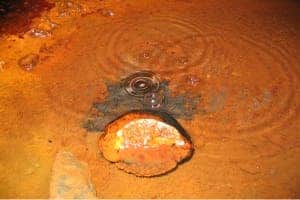Buried deep at some 2.4 kilometers beneath the surface, in the vicinity of an underground mine near Ontario, Canada, scientists have stumbled across what may actually be the oldest water on Earth. Isolated for more than a billion years, the water pocket holds invaluable clues that may hint how ancient life formed, while also shinning hope that similar deposits may exist on Mars too, once a watery world much like Earth.

Water filtering out of the floor of a deep Ontario mine has been trapped underground for more than a billion years. It bubbles with gasses carrying nutrients that could sustain microbial life.
(c) J TELLING
These ancient pockets of water were analyzed by researchers from the Universities of Toronto, Lancaster, Manchester and McMaster, and were found in a copper and zinc mine near Timmins, Ont. Scientists aren’t yet sure for how long it’s been isolated, estimates ranging from one to 2.64 billion years, far longer than anything previously discovered.
Upon analyzing the water, which was carefully extracted through tiny cracks in order to avoid contaminants from the mine, the researchers found that it is rich in dissolved gases such as hydrogen, methane and other forms of noble gases like argon, xenon, helium and neon. Regarding the hydrogen content, the researchers found that it is akin to that found around hydrothermal vents in the deep ocean. They conclude that this ancient, well hidden pocket of water holds the right conditions for supporting life, despite they’ve yet to identify any microbes or such.
“These are the oldest waters that have ever been identified,” Barbara Sherwood Lollar, a geoscientist at the University of Toronto and one of the study’s authors, told The Canadian Press. “We don’t know yet if there’s life in this, but what we’ve been able to show is it is habitable, meaning (having the) potential to support life because of the energy that’s there.”
To determine how long the water had been isolated from the atmosphere, the scientists examining the levels of certain isotopes of noble gases and came to the conclusion that it had been for sure tucked away from the rest of the world for at least one billion years.
“We’ve found an interconnected fluid system in the deep Canadian crystalline basement that is billions of years old, and capable of supporting life. Our finding is of huge interest to researchers who want to understand how microbes evolve in isolation, and is central to the whole question of the origin of life, the sustainability of life, and life in extreme environments and on other planets,” Chris Ballentine, of the University of Manchester, co-author of the study and project director, says in a press statement.
Prior to this groundbreaking find, ancient water findings were limited to droplets trapped in bubbles in rock, these were not capable of supporting life however. Since the water pocket was discovered within the volcanic rock of the Canadian Shield, an environment similar to Mars’ rocky subterranean, some researchers hold hope that it might be possible for such deposits to be present beneath the planet’s polar caps as well.
“Our Canadian colleagues are trying to find out if the water contains life right now. What we can be sure of is that we have identified a way in which planets can create and preserve an environment friendly to microbial life for billions of years. This is regardless of how inhospitable the surface might be, opening up the possibility of similar environments in the subsurface of Mars,” said Dr. Greg Holland of Lancaster University, lead author of the study.
The findings were presented in the journal Nature (doi:10.1038/nature.2013.12995).









